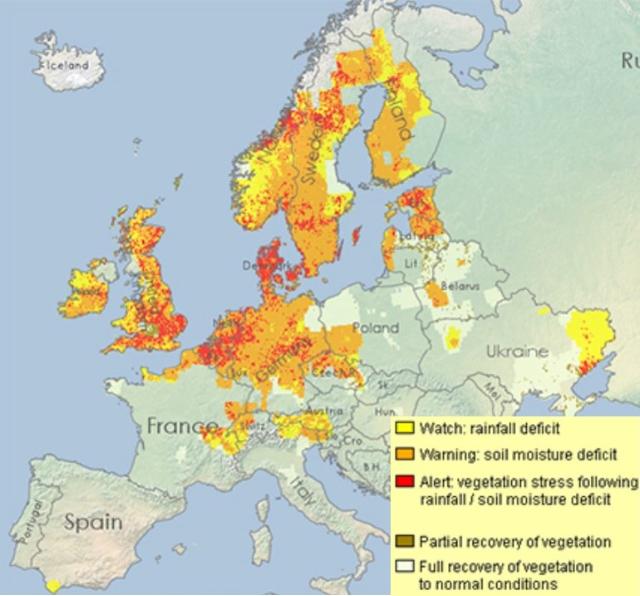Improved drought-resistance protects agricultural profits
During hot, dry summers valuable grassland loses its lush green colour. The longer the drought, the more brown the grass becomes. Week by week, the grass additionally loses biomass, and dry-matter yields decline. Europe’s increasingly frequent spring and summer droughts are creating more forage gaps that reduce agricultural profits

Climate change makes dry periods more likely
Since no one can predict the weather for the year ahead, there will always be uncertainty for farmers and for the forage grasses they grow
But things are changing. In recent years (2018, 2019 and 2020), drought has been a more frequent problem across many regions of Europe. You can see a snapshot of the extent of the 2018 drought below. The image is from the European Commission's Combined Drought Indicator for a ten-day period during August of that year. The lack of rainfall affected Germany, The Netherlands, Southern Europe, and even the UK and Scandinavia.
Combined Drought Indicator for the second ten-day period of August 2018 (Source: European Commission, 2021)

Research proves that PLUS-grasses are more drought-tolerant
DLF’s goal is to bring drought-tolerant grass varieties to the market to secure forage yields
The superior drought-tolerance of Ryegrass PLUS and Tall Fescue PLUS has been proven twice over: by ongoing research at the unique RadiMax root-screening facility and by measurement of agronomic performance across DLF’s worldwide field-testing network. The results from RadiMax and field testing clearly show that Ryegrass PLUS and Tall Fescue PLUS are an efficient solution to the drought challenges of the future.
Drought- tolerance and increased yield potential with PLUS-grasses
DLF researchers work with established research institutes to find solutions to drought damage. We look above and below ground – at what’s happening to the grass and how the mechanisms of root growth work to develop robust drought-tolerant grasses.
Ryegrass PLUS: Ryegrass PLUS displays dominant ryegrass characteristics with the added benefits of fescues. The pairing gives it the ability to grow deeper roots. This makes Ryegrass PLUS ideal for boosting the drought-tolerance and forage quality of overseeding mixtures. With Ryegrass PLUS in a mixture, yield potential and energy content are increased, and the persistency of the sward is improved.
Tall fescue PLUS: Tall Fescue PLUS displays dominant tall fescue characteristics with the added benefits of ryegrass. Incorporating the deep-rooting feature of Tall Fescue PLUS in a mixture increases its tolerance to climate changes, while raising yield potential and forage quality. Tall Fescue PLUS is ideal for long-lasting mixtures. It improves forage digestibility and secures farm profits through high drought-tolerance
About RadiMax
DLF – together with Copenhagen University – is researching the root architecture of turf and forage grass varieties at the RadiMax facility
RadiMax is the world’s most advanced root-screening facility. It lets researchers capture images of growing roots down to a depth of 3.0 m. At the same time, the plants can be exposed to increasing degrees of drought through a controlled soil-moisture gradient. Researchers can see how different grasses perform during a drought, and directly relate their performance to their root architecture.
RadiMax facility – a DLF root-screening project run in cooperation with Copenhagen University